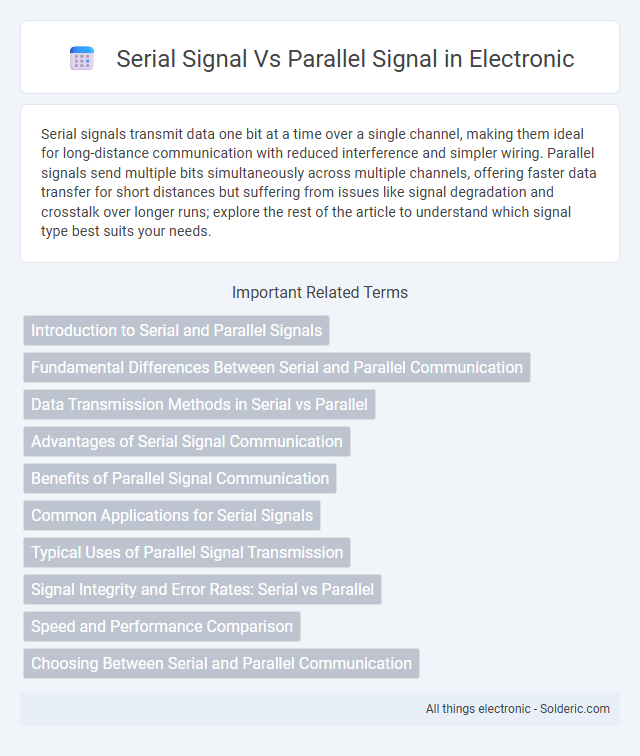Serial signals transmit data one bit at a time over a single channel, making them ideal for long-distance communication with reduced interference and simpler wiring. Parallel signals send multiple bits simultaneously across multiple channels, offering faster data transfer for short distances but suffering from issues like signal degradation and crosstalk over longer runs; explore the rest of the article to understand which signal type best suits your needs.
Comparison Table
| Aspect | Serial Signal | Parallel Signal |
|---|---|---|
| Data Transmission | One bit at a time | Multiple bits simultaneously |
| Wiring | Fewer wires/cables | Multiple wires/cables |
| Speed | Slower at short distances, fast on long distance with modern tech (e.g., USB, SATA) | Faster at short distances |
| Interference | Less prone to signal crosstalk and electromagnetic interference | More prone to interference due to parallel lines |
| Distance | Supports longer distances efficiently | Limited over longer distances due to signal degradation |
| Complexity | Simpler hardware design | More complex hardware with synchronization issues |
| Examples | USB, RS-232, SATA | PCI, older printer ports, IDE |
Introduction to Serial and Parallel Signals
Serial signals transmit data one bit at a time over a single channel, ensuring simpler wiring and longer transmission distances suitable for communication protocols like RS-232 and USB. Parallel signals send multiple bits simultaneously across multiple channels, offering higher data transfer rates ideal for short-distance connections such as computer buses and internal data paths. The choice between serial and parallel transmission depends on factors like speed requirements, signal integrity, and physical cable complexity.
Fundamental Differences Between Serial and Parallel Communication
Serial communication transmits data bits sequentially over a single channel, reducing wiring complexity and allowing longer cable lengths with less signal degradation. Parallel communication sends multiple bits simultaneously across multiple channels, enabling faster data transfer rates over short distances but facing issues like signal skew and electromagnetic interference. The fundamental difference lies in the number of data paths used and the trade-off between speed, cost, and distance efficiency.
Data Transmission Methods in Serial vs Parallel
Data transmission methods in serial signal involve sending bits sequentially over a single channel, enhancing long-distance communication with reduced interference and lower cable costs. Parallel signal transmission sends multiple bits simultaneously across multiple channels, offering faster data transfer rates ideal for short distances but suffering from signal degradation and crosstalk over longer cables. The choice between serial and parallel transmission depends on factors like distance, speed requirements, and hardware complexity.
Advantages of Serial Signal Communication
Serial signal communication offers the advantage of reduced wiring complexity, which minimizes costs and space requirements in electronic systems. It supports high-speed data transmission over longer distances with less signal degradation compared to parallel signals. Serial communication also enables simpler synchronization and enhanced noise immunity, improving overall reliability in data transfer.
Benefits of Parallel Signal Communication
Parallel signal communication offers faster data transfer rates by sending multiple bits simultaneously across multiple channels, making it ideal for short-distance, high-speed applications like internal computer buses. This method reduces latency and enhances efficiency when transmitting large amounts of data within devices. Your systems benefit from improved performance and reduced processing time due to the simultaneous transmission of signals.
Common Applications for Serial Signals
Serial signals are widely used in communication interfaces such as USB, RS-232, and Ethernet due to their efficient data transmission over long distances with reduced wiring complexity. They enable reliable data exchange in devices like computers, microcontrollers, and networking equipment by sending bits sequentially on a single channel. Common applications also include storage devices (SATA), telecommunications, and embedded systems where space and cost savings are critical.
Typical Uses of Parallel Signal Transmission
Parallel signal transmission is typically used in short-distance communication scenarios such as computer buses, printers, and internal data transfer within devices where multiple bits are sent simultaneously across multiple channels. This method excels in situations demanding high data transfer rates and synchronization between sender and receiver, like in microprocessor communication and memory interface systems. Understanding your device's architecture can help determine if parallel transmission efficiently maximizes data throughput for your specific applications.
Signal Integrity and Error Rates: Serial vs Parallel
Serial signals maintain higher signal integrity over long distances due to reduced crosstalk and electromagnetic interference compared to parallel signals, which suffer from skew and timing mismatches among multiple lines. Error rates in serial communication are typically lower because synchronized timing and differential signaling techniques enhance noise immunity, whereas parallel communication often encounters increased bit errors from signal degradation and timing inconsistencies. The use of advanced encoding and error correction in serial data transmission further minimizes errors, making it superior for reliable, high-speed data transfer.
Speed and Performance Comparison
Serial signals transmit data one bit at a time over a single channel, typically allowing higher clock speeds and reduced electromagnetic interference, which enhances long-distance communication speed and reliability. Parallel signals send multiple bits simultaneously across multiple channels, offering faster data transfer rates at short distances but suffering from timing skew and crosstalk, limiting performance over longer cables. Modern high-speed applications favor serial communication technologies like USB 3.0 and PCIe for their superior speed, scalability, and signal integrity compared to traditional parallel interfaces.
Choosing Between Serial and Parallel Communication
Choosing between serial and parallel communication depends on factors like distance, speed, and cost. Serial communication transmits data bit by bit over a single channel, making it ideal for long distances and reducing electromagnetic interference. Parallel communication sends multiple bits simultaneously across multiple channels, offering higher data transfer rates but facing signal degradation and synchronization issues over extended distances.
Serial signal vs parallel signal Infographic

 solderic.com
solderic.com